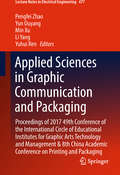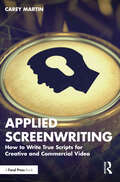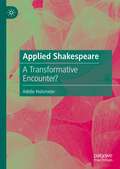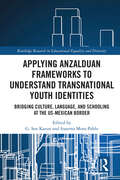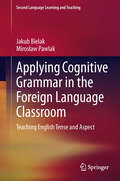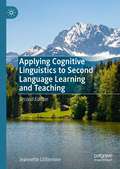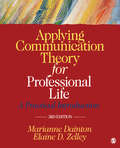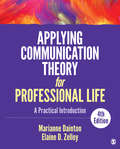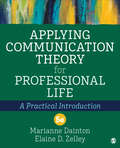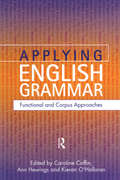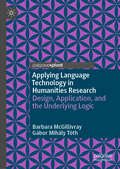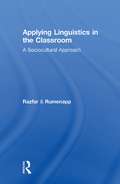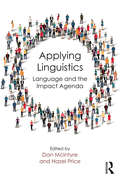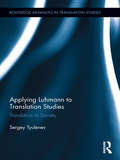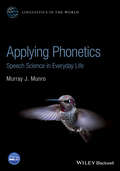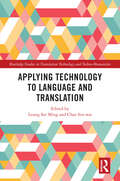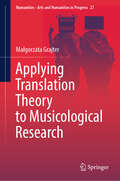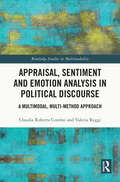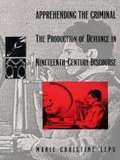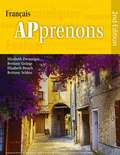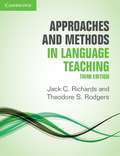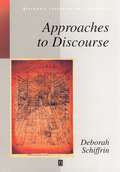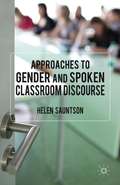- Table View
- List View
Applied Sciences in Graphic Communication and Packaging: Proceedings of 2017 49th Conference of the International Circle of Educational Institutes for Graphic Arts Technology and Management & 8th China Academic Conference on Printing and Packaging (Lecture Notes in Electrical Engineering #477)
by Min Xu Li Yang Yun Ouyang Pengfei Zhao Yuhui RenThis book includes a selection of reviewed papers presented at the 49th Conference of the International Circle of Educational Institutes for Graphic Arts Technology and Management & 8th China Academic Conference on Printing and Packaging, which was held on May 14-16, 2017 in Beijing, China. The conference was jointly organized by the Beijing Institute of Graphic Communication, China Academy of Printing Technology, and International Circle of Educational Institutes for Graphic Arts Technology and Management. With eight keynote talks and 200 presented papers on graphic communication and packaging technologies, the event attracted more than 400 scientists. The proceedings cover the latest advances in color science and technology; image processing technology; digital media technology; digital process management technology in packaging; packaging, etc. , and will be of interest to university researchers, R&D engineers and graduate students in the graphic arts, packaging, color science, image science, material science, computer science, digital media and network technology.
Applied Screenwriting: How to Write True Scripts for Creative and Commercial Video
by Carey MartinPutting a vision on the page for creative and commercial video is harder than it seems, but author Carey Martin explains how to bring these tools to bear in the “work for hire” environment. Whilst other texts focus on writing the next award winner, this can be out of reach both logistically and financially for many. Instead, readers will learn how to write what they want the eyes of the audience to see and the ears of the audience to hear, in such a way that the Producer and Director can read the creative blueprint and bring that vision to life. The text will walk readers through a focused and practical consideration of the camera, the edit, and the sound design, in addition to a straightforward application of basic story principles. By understanding writing for video as more than creating a recorded play, readers will become more effective screenwriters and, should they wish, Producers and Directors as well. This book is ideal for students of screenwriting and those writing scripts for message-driven video for corporate, nonprofit, and commercial production.
Applied Shakespeare: A Transformative Encounter?
by Adelle HulsmeierThis book speaks to those interested in where and why Shakespeare’s work is used to capture the transformative intentions of different areas of Applied Theatre practice (Prison, Disability, Therapy), representing a foundational study which considers subsequent histories and potential challenges when engaging with Shakespeare’s work. This is grounded in a case study analysis of three salient British Theatre Companies: The Education Shakespeare Company (prison), the Blue Apple Theatre Company (Disability), and the Combat Veteran Players (therapy).
Applying Anzalduan Frameworks to Understand Transnational Youth Identities: Bridging Culture, Language, and Schooling at the US-Mexican Border (Routledge Research in Educational Equality and Diversity)
by G. Sue Kasun Irasema Mora-PabloFramed by the theoretical work of Gloria Anzaldúa, this volume focuses on the cultural and linguistic practices of Mexican-origin youth at the U.S. border to explore how young people engage in acts of "bridging" to develop rich, transnational identities. Using a wealth of empirical data gathered through interviews and observations, and featuring perspectives from multinational and transnational authors, this text highlights how youth resist racialized and raciolinguistic oppression in both formal and informal contexts by purposefully engaging with their heritage culture and language. In doing so, they defy deficit narratives and negotiate identities in the "in-between." As a whole, the volume engages issues of identity, language, and education, and offers a uniquely asset-based perspective on the complexities of transnational youth identity, demonstrating its value in educational and academic spaces in particular. This text will benefit researchers, academics, and educators with an interest in the sociology of education, multicultural education, and youth culture more broadly. Those interested in language and identity studies, as well as adolescence, schooling, and bilingualism, will also benefit from this volume.
Applying Cognitive Grammar in the Foreign Language Classroom: Teaching English Tense and Aspect (Second Language Learning and Teaching)
by Mirosław Pawlak Jakub BielakThe monograph constitutes an attempt to demonstrate how Cognitive Grammar (CG) can be employed in the foreign language classroom with a view to aiding learners in better understanding the complexities of English grammar. Its theoretical part provides a brief overview of the main tenets of Cognitive Grammar as well as illustrating how the description of English tense and aspect can be approached from a traditional and a CG perspective. The empirical part reports the findings of an empirical study which aimed to compare the effects of instruction utilizing traditional pedagogic descriptions with those grounded in CG on the explicit an implicit knowledge of the Present Simple and Present Continuous Tenses. The book closes with the discussion of directions for further research when it comes to the application of CG to language pedagogy as well as some pedagogic implications
Applying Cognitive Linguistics to Second Language Learning and Teaching
by Jeannette LittlemoreThis is a revised and updated edition of a seminal text in the field of Cognitive Linguistics, written in an engaging and accessible style for a new generation of scholars and students. The author surveys and incorporates a wealth of more recent studies conducted in different areas since the book’s original publication in 2009, exploring how new areas of research within Cognitive Linguistics have emerged and flourished, and taking account of key studies that have progressed the field since its inception. This new edition has been revised throughout to review, analyse and synthesise the latest state of the art in Cognitive Linguistics–inspired second language learning and teaching research, and suggests other areas that might benefit from further exploration. It will be essential reading for academics, educators and students across Linguistics and Education, particularly those with an interest in cognitive linguistics, second language acquisition, foreign language teaching and language education.
Applying Communication Theory for Professional Life: A Practical Introduction
by Marianne Dainton Elaine D. ZelleyThis fully updated Third Edition of Applying Communication Theory for Professional Life helps readers understand communication theory and its importance to careers in communication and business. Practical and reader-friendly, the book offers succinct coverage of the major theories that have clear applicability to communication and business practitioners, including theories of intrapersonal communication, interpersonal interaction, intercultural encounters, persuasion, group communication, organizational behavior, social media, and mass communication. In every chapter, authors Marianne Dainton and Elaine D. Zelley illustrate how theory is applied in a variety of professional settings through real-world case studies.
Applying Communication Theory for Professional Life: A Practical Introduction
by Marianne Dainton Elaine D. ZelleyUpdated Edition of Bestseller! Applying Communication Theory for Professional Life, by Marianne Dainton and Elaine D. Zelley is the first communication theory textbook to provide practical material for career-oriented readers. Featuring new case studies, updated examples, and the latest research, the Fourth Edition of this bestseller introduces communication theory in a way that helps you understand its importance to careers in communication and business. Real-world case studies within each chapter are designed to illustrate the application of theory in a variety of professional settings. New to the Fourth Edition All case studies now include specific questions about ethical issues associated with the narrative of the case and how knowledge of theory can help you negotiate these ethical dilemmas. The simulated “Education as Entertainment Theory” includes apps and other new media forms of educational content, keeping you up-to-date with the latest technology. Four new case studies have been added to show you how the theories are tied to recent events. The cases are titled: 1. “You’re Fired” 2. “Bad Move” 3. “Million Dollar Manipulation” 4. “The (New) Media Culture Wars” New research and scholarship for all theories can be found in the “Chapter Summaries” and “Research Applications” of each chapter. Numerous political examples have been added to reflect the increasingly divergent political rhetoric in the United States.
Applying Communication Theory for Professional Life: A Practical Introduction
by Marianne Dainton Elaine D. ZelleyUpdated Edition of Bestseller! Applying Communication Theory for Professional Life, by Marianne Dainton and Elaine D. Zelley is the first communication theory textbook to provide practical material for career-oriented readers. Featuring new case studies, updated examples, and the latest research, the Fourth Edition of this bestseller introduces communication theory in a way that helps you understand its importance to careers in communication and business. Real-world case studies within each chapter are designed to illustrate the application of theory in a variety of professional settings. New to the Fourth Edition All case studies now include specific questions about ethical issues associated with the narrative of the case and how knowledge of theory can help you negotiate these ethical dilemmas. The simulated “Education as Entertainment Theory” includes apps and other new media forms of educational content, keeping you up-to-date with the latest technology. Four new case studies have been added to show you how the theories are tied to recent events. The cases are titled: 1. “You’re Fired” 2. “Bad Move” 3. “Million Dollar Manipulation” 4. “The (New) Media Culture Wars” New research and scholarship for all theories can be found in the “Chapter Summaries” and “Research Applications” of each chapter. Numerous political examples have been added to reflect the increasingly divergent political rhetoric in the United States.
Applying Communication Theory for Professional Life: A Practical Introduction
by Marianne Dainton Elaine D. ZelleyNow in its fifth edition, Applying Communication Theory for Professional Life is the first communication theory textbook to provide practical material for career-oriented students. Featuring new case studies, updated examples, and the latest research, authors Marianne Dainton and Elaine D. Zelley introduce communication theory in a way that helps students understand its importance to careers in communication and business. Real-world case studies within each chapters are designed for in-class use to illustrate the application of theory in a variety of professional settings. The Fifth edition features eight new theories, a new chapter on theories of strategic communication, and expanded discussions of mediated communication theories.
Applying Communication Theory for Professional Life: A Practical Introduction
by Marianne Dainton Elaine D. ZelleyNow in its fifth edition, Applying Communication Theory for Professional Life is the first communication theory textbook to provide practical material for career-oriented students. Featuring new case studies, updated examples, and the latest research, authors Marianne Dainton and Elaine D. Zelley introduce communication theory in a way that helps students understand its importance to careers in communication and business. Real-world case studies within each chapters are designed for in-class use to illustrate the application of theory in a variety of professional settings. The Fifth edition features eight new theories, a new chapter on theories of strategic communication, and expanded discussions of mediated communication theories.
Applying English Grammar.: Corpus and Functional Approaches
by Caroline Coffin Ann Hewings Kieran O'HalloranThis edited collection is about the application of English grammar and specialises in 'functional' and'corpus' approaches, approaches which are increasingly recognised as providing significant insights into English language in action. It aims to stimulate interest and understanding of grammar as an applied tool not just for grammarians or language learners, but for all those interested in how language is organized to shape our view of events in the world.As the chapters in this book show, functional and corpus approaches allow us to make observations that would not be amenable through more traditional forms of grammatical analysis. They also illustrate how researchers can fruitfully bring together corpus and functional approaches to reveal how grammar and lexis create and transmit values, identities and ideologies. Research in Critical Discourse Analysis (CDA) has a long tradition of drawing on functional grammar but has only relatively recently begun to draw on corpus linguistics. As such, the book is unusual in presenting work on CDA which draws on corpus linguistics. But not only that, it is also unique in presenting work in CDA which brings together the methodologies of corpus linguistics and functional grammar, demonstrating their combined potential for illuminating ideological perspectives, particularly in media texts.Given this focus and given the increasing value of empirical data, the book will be of interest to those in a range of disciplines including the humanities and media and cultural studies.Chapters comprise both newly commissioned and previously published works that illustrate the two methodological approaches to grammatical analysis and how they can be applied to deepen our understanding of language.
Applying Language Technology in Humanities Research: Design, Application, and the Underlying Logic
by Barbara McGillivray Gábor Mihály TóthThis book presents established and state-of-the-art methods in Language Technology (including text mining, corpus linguistics, computational linguistics, and natural language processing), and demonstrates how they can be applied by humanities scholars working with textual data. The landscape of humanities research has recently changed thanks to the proliferation of big data and large textual collections such as Google Books, Early English Books Online, and Project Gutenberg. These resources have yet to be fully explored by new generations of scholars, and the authors argue that Language Technology has a key role to play in the exploration of large-scale textual data. The authors use a series of illustrative examples from various humanistic disciplines (mainly but not exclusively from History, Classics, and Literary Studies) to demonstrate basic and more complex use-case scenarios. This book will be useful to graduate students and researchers in humanistic disciplines working with textual data, including History, Modern Languages, Literary studies, Classics, and Linguistics. This is also a very useful book for anyone teaching or learning Digital Humanities and interested in the basic concepts from computational linguistics, corpus linguistics, and natural language processing.
Applying Linguistics in the Classroom: A Sociocultural Approach
by Aria Razfar Joseph C. RumenappMaking linguistics accessible and relevant to all teachers, this text looks at language issues in the classroom through an applied sociocultural perspective focused on how language functions in society and in schools—how it is used, for what purposes, and how teachers can understand their students’ language practices. While touching on the key structural aspects of language (phonetics, phonology, morphology, and syntax), it does not simply give an overview, but rather provides a way to study and talk about language. Each chapter includes practical steps and suggests tools for applying different kinds of linguistic knowledge in classrooms. The activities and exercises are adaptable to elementary or high school settings. Many examples focus on the intersection of math, science, and language. Teacher case studies show how real teachers have used these concepts to inform teaching practices. Given the increasing use of multimedia resources in today’s schools, multiple mediums are integrated to engage educators in learning about language. The Companion Website provides a multitude of relevant resources that illustrate the diversity of language functions and debates about language in society.
Applying Linguistics: Language and the Impact Agenda
by Dan McIntyre Hazel PriceApplying Linguistics: Language and the Impact Agenda explores the challenges of demonstrating the socio-cultural and economic impact of research in linguistics. The chapters provide critical discussion of the concept of impact, as well as an examination of both the constraints and opportunities of the impact agenda. The book includes: case studies of impact-focused research from leading scholars, such as M. Lynne Murphy, David Britain, Peter French and Bas Aarts; discussion of impact from the perspective of the UK Research Excellence Framework (REF); insights and opinions from academics, practitioners and journalists; personal reflection on the nature of impact from the ESRC’s Interim Chief Executive; practical advice on generating and evidencing impact. With chapters from international authors exploring impact both within and outside the context of the UK REF, Applying Linguistics: Language and the Impact Agenda will be essential reading for early-career researchers, established academics and PhD students interested in developing impact from their research.
Applying Luhmann to Translation Studies: Translation in Society (Routledge Advances in Translation and Interpreting Studies)
by Sergey TyulenevThis book deals with one of the most prominent and promising developments in modern Translation Studies--the sociology of translation. Tyulenev develops an original way of applying Luhmann's Social Systems Theory to translation, viewing translation as a social-systemic boundary phenomenon. The book consists of two major parts: in the first, translation is described as a system in its own right with its systemic properties; in the second part, translation is viewed as a social subsystem and as a boundary phenomenon in the overall social system.
Applying Phonetics: Speech Science in Everyday Life (Linguistics in the World)
by Murray J. MunroA unique and accessible introduction to the field of phonetics through real-life applications and practical examples The dynamic field of phonetics, the science of the structure and function of human speech, has seen exciting technological innovations and new applications in recent years. Applying Phonetics introduces students to the field through a unique exploratory approach that highlights practical applications and focuses on the diverse ways in which the speech sciences influence daily life. Requiring no prior knowledge of linguistics, this accessible, student-friendly textbook introduces the key concepts in phonetics and explains their relevance to contemporary applications. Even students who have completed introductory linguistics courses will discover plenty of new material in this volume. Rather than immediately delving into complex theoretical information, the text presents a brief overview of basic concepts and then uses applications—speech synthesis, forensic speech science, language teaching—to explain the details. This unique approach increases student interest and comprehension, clearly demonstrating how speech science is beneficial to society. Engaging, easily-relatable topics include speech anatomy and physiology, the nature of normal and disordered speech development, the origins of speech, and speech applications in forensics, music, drama, film, and business. Written by a respected expert with over 25 years’ experience teaching linguistics and phonetics, this textbook Explores the wide-ranging applications of phonetics areas such as accessibility, computer speech, education, the fine arts, and business Demonstrates how practical problems have been addressed through phonetics, such as the use of speech analysis for forensic purposes Presents real-life case studies that illustrate fundamental phonetics concepts Includes exercises and activities, discussion questions, an extensive glossary, further readings, and a companion website Applying Phonetics: Speech Science in Everyday Life is an ideal text for undergraduate students with no prior knowledge of linguistics, as well as those needing to expand their knowledge of phonetic principles. It will appeal to students in education, computer science, cognitive science, biology, psychology, business, and music.
Applying Technology to Language and Translation (Routledge Studies in Translation Technology)
by Leung Sze Ming and Chan Sin-waiA cutting-edge collection of work on the influence and application of new technologies on the study and practice of language and translation. This book analyzes the relationship between technology, language, and translation in the digital age. Language issues covered include an automatic football commentary system, the use of digital humanities in the versification of Classical Chinese poetry, the application of corpus linguistics in identity construction in Hong Kong, Cantonese speech recognition, and the use of AI in a Chabot system. Other chapters look at translation matters, such as technologies for interpreting, neural machine translation for press releases, computer-aided annotation for translator and interpreter training, and artificial intelligence and translation. As language and translation are closely intertwined, together, these chapters illustrate the drastic changes that technology has brought to these combined areas. A vital resource for scholars and students studying the impact of technology on language and translation.
Applying Translation Theory to Musicological Research (Numanities - Arts and Humanities in Progress #27)
by Małgorzata GrajterThis monograph lays the foundation for new methodologies of research between music and translation. It is the first such holistic attempt—from the perspective of a musicologist—based on the adaptation of translation theories. Until now, these fields have remained underexplored together. Only recently have the tools developed by translation theory permeated into musical scholarship. Such tools should prove as a promising alternative to those offered by classic musicological studies, particularly in reference to musical arrangement, pop music covers and performance. Theoretical discussion on topics are supported by case studies. This text appeals to musicologists and musicians as well as experts in the field of translation theory who are interested in expanding their field of inquiry.
Appraisal, Sentiment and Emotion Analysis in Political Discourse: A Multimodal, Multi-method Approach (Routledge Studies in Multimodality)
by Claudia Roberta Combei Valeria ReggiThis book adopts a multi-method multimodal approach to the study of online political communication, applying it to case studies from the UK, France, and Italy toward offering a portrait of the rapid ideological shifts in contemporary Western democracies. The volume introduces an integrated framework combining Sentiment and Emotion Analysis, rooted in lexical semantics, and the qualitative dimensions of Appraisal Theory, applying it to large corpora of online political communication from the UK, France, and Italy. Combei and Reggi highlight their combined potential in analyzing the multimodal resources in such discourses and in turn, revealing fresh insights into layers of subtext and the ways in which parties and movements frame their political programmes and values. The authors also take into account culture- and language-specific variables across the three countries in shaping such discourses. The volume makes the case for an integrated methodological framework that can be uniquely applied to better understand the multimodal communicative landscape of divisiveness in today’s rapidly shifting political climate and other forms of online communication more broadly. This book will be of interest to students and scholars in digital communication, political communication, multimodality, and qualitative and quantitative discourse analysis, especially those interested in corpus-assisted approaches.
Apprehending the Criminal: The Production of Deviance in Nineteenth Century Discourse
by Marie-Christine LepsIn this wide-ranging analysis, Marie-Christine Leps traces the production and circulation of knowledge about the criminal in nineteenth-century discourse, and shows how the delineation of deviance served to construct cultural norms. She demonstrates how the apprehension of crime and criminals was an important factor in the establishment of such key institutions as national systems of education, a cheap daily press, and various welfare measures designed to fight the spread of criminality.Leps focuses on three discursive practices: the emergence of criminology, the development of a mass-produced press, and the proliferation of crime fiction, in both England and France. Beginning where Foucault's work Discipline and Punish ends, Leps analyzes intertextual modes of knowledge production and shows how the elaboration of hegemonic truths about the criminal is related to the exercise of power. The scope of her investigation includes scientific treatises such as Criminal Man by Cesare Lombroso and The English Convict by Charles Goring, reports on the Jack the Ripper murders in The Times and Le Petit Parisien, the Sherlock Holmes stories, Stevenson's Strange Case of Dr. Jekyll and Mr. Hyde, and novels by Zola and Bourget.
Apprenons: Francais
by Elizabeth Zwanziger Brittany Goings Elizabeth Rench Brittany Selden GriffinNIMAC-sourced textbook
Approaches and Methods in Language Teaching
by Jack C. Richards Theodore S. RodgersAn extensively revised and updated edition of this popular and accessible text. Approaches and Methods in Language Teaching Third edition is an extensive revision of this highly successful book. As in previous editions, both major and alternative approaches and methods are surveyed, with the section on current communicative approaches updated to include new material on CLIL, text and genre-based teaching. The book seeks not only to clarify the assumptions behind these approaches, and their similarities and differences, but also to help teachers explore their own beliefs and practices in language teaching. Further new material deals with other directions in language teaching, such as outcomes-based initiatives, to make this edition fully up-to-date.
Approaches to Discourse (Blackwell Textbooks in Linguistics)
by Deborah Schiffrin<p>This is a guide to the various frameworks, concepts, and methods available for the analysis of discourse within linguistics. It compares six dominant approaches to discourse analysis: speech act theory, pragmatics, ethnomethodology, interactional sociolinguistics, ethnography of communication, and variation theory. <p>The author not only considers each approach from several standpoints but she also illustrates them through extensive applications to a variety of concrete social and linguistic problems facing discourse analysts.</p>
Approaches to Gender and Spoken Classroom Discourse
by Helen SauntsonGender is a hotly debated topic in the field of education. The role that language plays in educational contexts especially in the classroom has long been acknowledged. Innovatively combining approaches in the analysis of classroom discourse this book offers rich empirical findings as well as being theoretically interesting and valuable.
